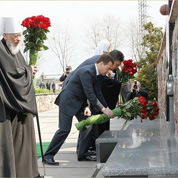Japan’s tragedy and Chernobyl 25th anniversary question atomic energy necessity

Former Soviet republics and, indeed, the whole world, on April 26 marked the 25th anniversary of the Chernobyl disaster, now officially recognized as the most devastating technogenic catastrophe in human history. This tragedy is one of few misfortunes, whose intensity, and survivors’ utter helplessness and horridness of unprecedented destruction of lives and ecology do not diminish with time, as the Chernobyl cataclysm has continued to claim more victims and wreak havocs 25 years on.
"To put a perspective on the magnitude of the material losses, suffice it to say that the explosion energy from the blast was almost 400-500 times more potent than the atomic bombs dropped by the United States on the Japanese cities of Hiroshima and Nagasaki in 1945, then viewed as humanity’s worst anthropogenic catastrophes."
To put a perspective on the magnitude of the material losses, suffice it to say that the explosion energy from the blast was almost 400-500 times more potent than the atomic bombs dropped by the United States on the Japanese cities of Hiroshima and Nagasaki in 1945, then viewed as humanity’s worst anthropogenic catastrophes. This vast energy predefined the scale of Chernobyl's deadly radiation contaminations legacy, covering an area of 150,000 sq. km in Russia, Ukraine and Belarus.
For instance, Minsk has estimated the gross damages from the direct impacts of the tragedy and related negative fallouts over the past 25 years at $235bln; while Kiev has put its estimates at $180bln, and rising. Though Russia has yet to disclose its estimated losses, the figures are also expected to be equally overwhelming. Indeed, the exact sum of cumulative losses have continued to elude precise mathematical computation, first due to the lack of transparency over nuclear issues in general and the Chernobyl tragedy in particular, during the Soviet times, and secondly due to the continuation of losses from the ongoing deadly radiation contaminations that have made previously viable vast lands absolutely unsuitable for any useful purposes without posing health hazards. The scale of the tragedy was further exacerbated by the legendary infamous Soviet officialdom and its callous policy of putting state’s interests above its citizens’ welfare.
Besides, the displaced Chernobyl region refugees and surviving liquidators now need lifetime support from the state, totaling billions per year, which are putting additional financial pressures on the worst-hit states. Besides, deadly radiation exposure-related diseases have continued to decimate this caste of exceptionally brave men and women, who selfishly put their lives on the line to save not only the Soviet citizens, but the entire humanity in 1986. The worst thing is that the Chernobyl nightmares are not yet over as the sarcophagus that was used to contain the deadly contaminants from the epicenter of the blast has now become obsolete, while ongoing global efforts to generate the $1.6bln needed to build a new one have yielded only half of the needed sum.
Whilst these negative fallouts from the Chernobyl horrors are mostly felt by the post-Soviet states of Ukraine, Belarus and Russia due to their geographical proximity to the center of the disaster, citizens in other parts of the globe, who had grown immune to the apocalyptic prognoses of Greenpeace and other ecology advocates over the dangers posed by atomic energy, were brought back to stark reality facing humanity in March 2011 by the Japanese tragedy at the Fukushima-1 nuclear reactors. Interestingly, the ensuing threat of nuclear blast, which due to its deadly radiation capabilities, has pushed all other problems in the country to the background, including thousands of victims of the almost ten-magnitude earthquake that prompted the tsunamis that destroyed the reactors and caused the consequent contaminations of people and environment.
"Citizens in other parts of the globe, who had grown immune to the apocalyptic prognoses of Greenpeace and other ecology advocates over the dangers posed by atomic energy, were brought back to stark reality facing humanity in March 2011 by the Japanese tragedy at the Fukushima-1 nuclear reactors."
Indeed, the Fukushima case has once again highlighted the precariousness of nuclear technologies in general, and the so-called ‘peaceful atomic energy’ in particular, especially as the technologies applied in the Japanese reactors were more advanced than those at Chernobyl, but all the same, they still failed to prevent this tragedy. Today, the so-called ‘nuclear power nations’ are divided on how best to tap the enormous energy trapped in atoms without endangering the world. Common logic dictates that it is best to avoid extremities such as banning atomic energy in all its entirety, as proposed by some EU states, or assuming that the circumstances that led to these colossal tragedies are ‘classical force majeure cases’ that will never be reduplicated in other areas, as being advocated by Russia and others.
"Today, the so-called ‘nuclear power nations’ are divided on how best to tap the enormous energy trapped in atoms without endangering the world. Common logic dictates that it is best to avoid extremities such as banning or recklessly pursing atomic energy policies."
Today, this is why the world needs to take a more critical look at the causes of the three most devastating nuclear accidents, notably, the Three Mile Island explosion in 1979 in the United States, Chernobyl and Fukushima. It also needs to avoid the type of absolute confidence among nuclear experts in the near-absolute safety of modern atomic reactors as well as unjustified economization of the costs of their exploitations. We owe this at least to the irradiated Chernobyl disaster liquidators, the so-called Japanese ‘nuclear samurais’ currently risking their lives, cleaning up the Fukushima radiation contaminations. Similarly, we also owe this to probable future nuclear disasters rescue teams, who could be our children and grandchildren whom, God forbid, might be called upon in the future by their beloved governments to risk their lives for the sake of humanity in case of future nuclear accidents.












 Web design,
Web design,